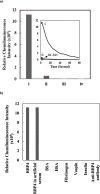Ultrasensitive nano-aptasensor for monitoring retinol binding protein 4 as a biomarker for diabetes prognosis at early stages
- PMID: 31953481
- PMCID: PMC6969062
- DOI: 10.1038/s41598-019-57396-6
Ultrasensitive nano-aptasensor for monitoring retinol binding protein 4 as a biomarker for diabetes prognosis at early stages
Abstract
Prognosis of diabetes risk at early stages has become an important challenge due to the prevalence of this disease. Retinol binding protein 4 (RBP4), a recently identified adipokine, has been introduced as a predictor for the onset of diabetes type 2 in coming future. In the present report a sensitive aptasensor for detection of RBP4 is introduced. The immune sandwich was prepared by immobilizing biotinylated RBP4 aptamers on streptavidin coated polystyrene micro-wells and then incubation of RBP4 as target and finally addition of luminol-antibody bearing intercross-linked gold nanoparticles as reporter. The chemiluminescence intensity was recorded in the presence of hydrogen peroxide as oxidant agent and Au3+ as an efficient catalyst for luminol oxidation. The aptasensor responded to RBP4 in the linear concentration range from 0.001 to 2 ng/mL and detection limit was slightly less than 1 pg/mL. The proposed method has successfully applied to determine the RBP4 in patient real serums. By using the intercross-linked gold nanoparticles, it is possible to provide more accessible surface for immobilizing luminol and enhance the chemiluminescence signal. Therefore, the analytical parameters such as sensitivity, specificity, detection limit and linear range were improved in compare to the biosensors reported in the literature.
Conflict of interest statement
The authors declare no competing interests.
Figures




References
-
- Wei, Y. et al. Serum retinol binding protein 4 is associated with insulin resistance in patients with early and untreated rheumatoid arthritis. Joint Bone Spine, 10.1016/j.jbspin.2018.07.002 (2018). - PubMed
Publication types
MeSH terms
Substances
LinkOut - more resources
Full Text Sources
Medical
Miscellaneous

